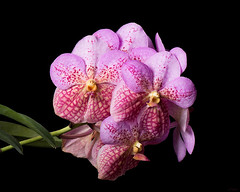Cattleya harrisoniana is one of my favorite orchids. It was described in 1836 by John Bateman and Lindley, in Volume 22 of Edward’s Botanical Registry (which began publication of its ?# of volumes in 1829), and named after Mrs. Arnold Harrison, an avid orchidist of her day and honored with the names of several other species such as Bifrenaria harrisoniae.
Linden argued for the species C. harrisoniana being subsumed into C. loddigesii as a variety in 1887 in Lindenia, Vol.15, 1899 – 1900, t.682, pp 744-746, as he considered the one a simply a subspecies of the other: With a series of specimens I am unable to separate C. Harrisoniana (an earlier name than Harrisoniae) [from C. loddigesii], except as a variety. Whether his refutation was truly heeded I cannot determine, as C. harrisoniana continued to be considered a species. The confusion between the two was immediately addressed that same year in the Gardeners’ Chronicle, disputing Linden’s work. C. harrisoniana has been described repeatedly since as a “good” species, including the first formal description of the alba form of harrisoniana in 2004 ((Beer) F.Barros & J.A.N.Bat., Orquidologia Sul-Amer.: 101 (2004)). In general, it is accepted that C. harrisoniana blooms in the summer months from green sheaths. There are several other floral differences, but I will save those for a later discussion.
The “blue” form of C. loddigesii has been awarded 4 times, but at least two of those awards have gone to what are obviously C. harrisoniana or introgrades of that species. Direct inspection of flowers of ‘Blue Sky’ reveal a flower with heavier substance and a greater number of flowers than C. loddigesii. The plant blooms from a green sheath, typically in the summer months. In fact, ‘Blue Sky’ won an AM/AOS (80 points) in May of 1987, long after loddigesii has finished blooming. Selfings of ‘Blue Sky’ are very similar to the parent, often having better form and occasional punctate markings. Like their parent (and all other harrisoniana clones), they bloom in the summer months.
Two other clones have won awards fromthe AOS. ‘Isa’ was awarded twice, receiving a AM/AOS (88 pts) in March 1997, znd upgraded to an FCC/AOS (91 pts) again in March of 1998. I have no idea of the provenance of ‘Isa’, and have never had the privelege of examining a flower of this clone. However, the timing of the blooming (March) is in between both loddigesii and harrisoniana. In and of itself, this timing does not rule out either species. The plant was awarded in Costa Rica, and differing cultural conditions can affect a plant’s blooming cycle . The timing does suggest to me possible introgression between both species, and possibly even intermedia! I am also not famailiar with the provenence of the clone ‘Kyleidoscopy’, which received its AM/AOS (85 pts) under the culture of Kyle Saunders in July of 2007. This blooming date strongly places the plant into the camp of C. harrisoniana.
The quest for the true blue Cattleya will never be achieved, but some flowers definitely approach purple! Coerulea forms of C.harrisoniana have been used in creating a small number of other coerulea hybrids, and their coerulea genetics seem compatible with both the labiate and bifoliate Cattleya species. Most of these are F1 hybrids, and unfortunately have not been used to any great degree in further breeding. However, harrisoniana contributes excellent carriage, flower count, and substance to its offspring, as well as a degree of flatness, and so should probebly be used more often. The most common coerulea harrisoniana hybrids are Heathii (loddigesii x walkeriana), and Minerva (loddigesii x bowringiana). I believe that a tetraploid coerulea Dubiosa (trianaei x harrisoniana) would open many doors for the hybridist interested in blues.
- A selfing of the clone ‘Blue Sky.’
- A second selfing of blue sky, and technically fma. coeurulea punctata!
- The back of the sepals of this selfing of ‘Blue Sky’ show the punctate markings well.
- C. Minerva (loddigesii x bowringiana). Photo by Ed Merkle
- C. Valentine coerulea (C. loddigesii x C. warneri)
- A close up of the lip of C. Valentine coerulea
- C. Behrensiana (C.loddigesii x C. Schilleriana) C. Schilleriana is a primary hybrid between C. intemedia and L. purpurata, and an obvious choice to make other coerulea Cattleyas
- Another C. Valentine. Photo Ed Merkle
- Lc. Periwinkle Poetry (Cornelia x loddigesii) Cornelia has a large percentage of L. pumila, which has some notable coerulea forms.
- An unnamed hybrid, showing the potential for coerulea harrisoniana. Photo Ed Merkle
- C. Granier’s Charm, which is Minerva x warscewiczii
- walkeriana x loddigesii
















The RHS is now interested in knowing what taxonomist will write in so many words that ‘Blue Sky’ is in fact hatrrisoniana, as a bunch of hybrid records will have to be updated. Whom would you recommend? = Carson Barnes